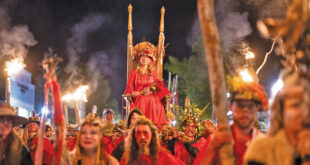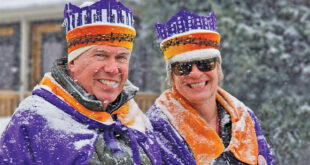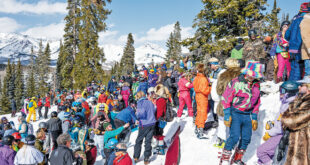A new program improves performance in ski area employees
A new program is dramatically reducing injury rates among ski area employees, and it’s doing so with deceptively simple changes to diet and fitness.
Rather than introducing more safety regulations or monitoring, Fit for Snow has a decidedly do-it-yourself approach to improving performance—and that, in turn, improves injury rates.
“For people at ski resorts, it’s all about on-snow performance,” says Dr. Delia Roberts, a professor at British Columbia’s Selkirk College. She visited Crested Butte Mountain Resort (CBMR) at the start of the ski season. CBMR is one of the first Colorado ski resorts to implement the Fit for Snow program. Dr. Roberts developed Fit for Snow in Canada after conducting research at British Columbia ski areas. She’s learned how to approach ski area employees. “I don’t talk about injury prevention because they are more focused on performance,” she said.
And yet injury rates drop dramatically. During the program’s first year, participating resorts saw worker compensation claims drop by an average of 67 percent; the total number of incidents dropped by about 25 percent. A comparison group of resorts that did not participate in the program saw a 10 percent increase in workers’ compensation claims during the same time period.
Those are significant results in an industry with a high occupational injury rate. According to data from go2hr, an advisory group for the hospitality industry in British Columbia, ski instructor injuries accounted for more than half of all accident claims on British Columbia ski hills between 2009 and 2013. Lift attendants came in second at just over 20 percent, and patrollers came in at 12 percent. Colorado ski resorts like CBMR are hoping that Fit for Snow can help reduce similarly high injury rates in the United States and give employees extra benefits.
According to Jess Caskey, human resources manager for CBMR, the resort brought in the Fit for Snow program because of its do-it-yourself approach. Employees can do the program on their own time rather than having to squeeze classes or on-site offerings into their schedules.
“It’s a program they can do at home. It’s self-motivated and it gives them the tools they need to do it,” Caskey said. She and HR specialist Jamie Delvernois are helping spearhead the program at CBMR with the guidance of Dr. Roberts, who visited the resort in December and will return in March, and nine volunteer staff advocates. The advocates have received additional training from Dr. Roberts and will offer further training to their departments.
“What excited us was that it’s not an assessment program, it’s educational,” added Delvernois. She explained that Dr. Roberts first caught the HR department’s attention when she spoke at the National Ski Areas Association and later at a conference run through the resort’s insurance carrier.
In Colorado, the Fit for Snow program is being run at only a handful of resorts, including Steamboat, Arapaho, and Granby Ranch.
“For Crested Butte to be on the forefront of this type of program puts us at the top of our game, and it’s an extra benefit we can give to our employees,” Caskey said. So far, the program has been well received—in part because it so clearly links the information to improvements in performance.
The science behind the program
During the 2010-2011 ski season, Dr. Roberts studied ski instructors, lift ops and ski patrollers at five British Columbia ski resorts. She started by assessing fitness, nutrition, and the physical demands of their jobs—and what she found surprised her.
“In my mind, the people who would go to a resort and work for a year would be hard-core riders and skiers who would be athletes. I actually found that in the majority of cases people were not as fit as I thought they would be,” she said.
Very few participants had the stability or endurance to complete activities that mimicked on-the-job tasks like lifting skis, shoveling, or balancing on one ski, particularly when fatigued. Many participants also used stabilization strategies that increased their risk of injury by improperly loading joints. Add to that an already high rate of previous injury (91 percent) and there was no question that employees were at risk for further injury.
And when Dr. Roberts examined blood sugar levels and hydration—two key factors in an individual’s reflexes, decision making and reaction times—she found that more than half of participants reported experiencing symptoms of low blood sugar. That’s significant given Dr. Roberts’ findings that 60 percent to 80 percent of injuries occur in the late morning and afternoon, when blood sugar levels tend to be low.
Dr. Roberts believed that teaching employees to stabilize blood sugar and practice better postures on the job could result in fewer injuries. She implemented the trainings, saw dramatic drops in injury rates, and the Fit for Snow program was born.
Simple changes, big results
When Dr. Roberts meets with ski area employees, she starts by giving them the basics—how to eat to avoid drops in blood sugar, and how to properly engage the core when skiing, lifting, or shoveling. It’s deceptively simple stuff, but on the hill, where employees have to make quick decisions, these basics can have big consequences. Everyone has a baseline reaction time, she explains, and if blood sugar is variable that can delay a person’s reaction time up to three quarters of a second. For a truck driver going 50 kilometers per hour (about 31 miles per hour), that’s 15 feet of stopping distance.
“When you’re smoking down through the trees, half a second can determine whether you hit a tree or not,” Dr. Roberts said. The key is to stay fueled up with complex carbohydrates and low-fat protein, and it starts first thing in the morning—Dr. Roberts recommends a smoothie or an apple and half a piece of toast within an hour of waking up. The body stores carbohydrates in only two places, one of which is the liver. Overnight, this store is used up and a light breakfast tops off the tank.
 The Crested Butte News Serving the Gunnison Valley since 1999
The Crested Butte News Serving the Gunnison Valley since 1999




